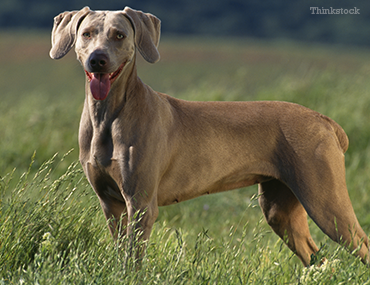Background
The Weimaraner was developed in Germany’s Weimar court in the early 19th century. Although similar dogs can be traced back to the 13th century the exact breed lines of the Weimaraner aren’t clear: Partially, because for many years Germany didn’t want to share the Weimaraner with the rest of the world. He’s the ideal hunting dog for large game, and has adapted to bird hunting without skipping a beat.
The immigration of the Weimaraner into the US was slow, with many being sterilized before they were sent from Germany. Finally in 1943 the breed was recognized by the American Kennel Club. In America he doesn’t compete in retrieving but is often used as a hunting dog.
Sizing up
 Weight: 55 - 82 lbs
Weight: 55 - 82 lbs- Height: 23 - 27 inches
- Color: Blue, gray, silver gray
- Coat: Short, hard and smooth
- Life expectancy: 12-15 years
Breed traits
The Weimaraner is all go and no stop. He requires vigorous exercise, every day, and often times he tires out his owner. The Weimaraner is possibly the most energetic of all the hunting dogs. He needs patience and a firm presence during training. He’s notoriously difficult to housetrain.
The first year and a half of the Weimaraner’s life will be particularly rambunctious but even after that he will never have anything less than a high level of energy. Lack of exercise can lead to behavioral issues including chewing on the furniture or just generally destroying the house.
The Weimaraner has a strong predilection to chase prey. That might include something as large as a buck or it might even be the family cat. His instinct is not only to chase but to kill the animal so he’s not a great choice for multiple pet households.
The Weimaraner is gentle and playful around children. He’s also an extremely loyal dog and will shadow his master everywhere. He shouldn’t be left alone and would also not do well at a kennel as he is fiercely devoted to his master.
The Weimaraner doesn’t have an undercoat and wouldn’t do well in extremely cold conditions.
The Weimaraner has a higher incidence of bloat or gastric torsion than dogs without a deep chest. Other conditions to watch for include the following:
- Cryptorchidism
- Elbow dysplasia
- Distichiasis
- Von Willebrands Disease
- Entropion
- Hypothyroidism
- Hypertrophic oseodystrophy
- Congenital peritoneopericardial diaphragmatic hernia
- Progressive retinal atrophy
- Hypomyelinogenesis
- Pituitary dwarfism
Right dog for you?
- Exercise needs: You should have plenty of time for exercise. The Weimaraner can run seven miles per day without a problem.
- Grooming: The Weimaraner doesn’t require much grooming.
- Work ethic: The Weimaraner would be an excellent hunting dog.
If you have any questions or concerns, you should always visit or call your veterinarian – they are your best resource to ensure the health and well-being of your pets.

